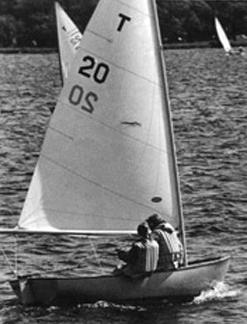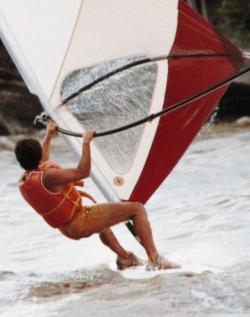
Thus I was a pretty decent sailor by the time I arrived at MIT in the Fall of 1959, and I improved my skills by taking a semester of sailing to satisfy my first quarter physical education requirement. About twenty percent of the student population learns to sail at MIT, which sits on the banks of the Charles river. Students can pop down to the sailing pavilion and go for a sail between classes, and I took full advantage of this. I was out on the river one quite windy day, when I noticed a Tech Dinghy (like the one shown in the photo above) that had gotten into trouble. The sailor appeared to be an MIT student with a date on board (a likely guess, because in the early sixties, the student population of MIT was about 97% male). His boat was swamped, which made it extremely unstable. He sat towards the stern with a hand on each gunwale, Note 1 carefully trying to balance the boat and keep it from fully capsizing. I had brought along a plastic bucket, to allow me to bail my boat if I took on any water. I passed alongside, and tossed the bucket into his boat, where it landed in front of his (presumed) date. She looked pretty panicked, and didn't take any action. I stayed nearby to see if I could help any further. "Bail!", he yelled to her over the wind. "What's that mean?", she yelled back. Since he was a logical MIT student, he proceeded to give her detailed instructions. He: "Fill the bucket with water from inside the boat." I noted that he had been careful to specify the source of the water. She: "OK". She did as instructed. He: "Throw it over the side." She: "OK". And she threw it. Bucket and all. His instructions apparently were not quite detailed enough. He: "No!" Releasing the gunwales, he held his head in both hands, which caused the boat to roll to the side, throwing them both into the water. I didn't need to intervene any further, as the motorized rescue launch had almost arrived from the sailing pavilion, where they had been following the situation closely through their binoculars. On another occasion, I presented myself at the sailing pavilion, eager to sail in a very strong wind. I was told that the wind was too strong for me to take a boat out alone; given the conditions, a crew was required for extra weight (dinghies, unlike larger sailboats with a heavy keel, depend on the weight of their occupants to counter the tipping force of the wind in the sail). There were no candidates in the pavilion itself, but I spotted a lone young woman hanging out on the sidewalk nearby. I approached her, and asked if she'd like to go for a sail. She said that she was waiting for her boyfriend, but that he wasn't due for another half an hour, so she was willing to come along.
Of course, understanding the physics and actually doing it are two different things. You still have to train your body to react automatically to make the needed adjustments - you don't have the luxury of taking time to analyze your moves. But still, the way I think, I'm much aided by understanding in detail the reasons why things work the way they do. We had some friends who at the time frequented a nude resort on a lake in Nottingham, New Hampshire called "Cedar Waters". We joined them there as guests on a couple of occasions, and on one of these visits, I found that another guest had brought a windsurfer. I prevailed on him to let me try it. My knowledge at the time being mainly theoretical, sailing the windsurfer took all my concentration and effort. Now that I've gotten good at it, it's fairly effortless, but as a beginner, my muscles were always tense, and it was exhausting. I sailed for half an hour, and thought I'd die. But after a rest, I gave it another try. Once out on the lake, I paid no attention to the fact that I was sailing naked, and actually, I completely forgot where I was. I was thinking only of what was needed to keep myself standing up on the board and under sail. At one point, fairly far away from the main beach, I passed by an uninhabited pontoon raft. I paid little attention to it, except to give it a wide enough berth so that if I were to fall down (always a possibility), my mast would not hit the raft. As I glided by, a stunning young woman popped up from a ladder on the opposite side, completely nude of course, strolled across the raft, and stretched out in the sun. Momentarily transfixed by this sight, I entirely lost my concentration, and plunged into the lake. And that's how I was knocked over by a beam of light. Sailing has given me a great deal of pleasure over the years, and continues to do so. I now own a windsurfer, and sail it from time to time on a lake in my home town. The rules keep me fifty feet away from the raft at the Town Beach, but that's OK. Everyone's wearing a bathing suit anyway.   Note 1: The word "gunwale" refers to the top edge of the side of a boat. Oddly, it's pronounce as if it were "gunnel", to rhyme with "tunnel". "Wale" is another word for a ridge - the ridges in corduroy fabric are called "wales". On fighting ships, cannons were lined up along this ridge on a ship, giving it the name "gunwale". This term was ultimately extended to smaller craft. [return to text] Note 2: "Sea shanty" is sometimes spelled "sea chantey", because it comes from the French verb chanter, "to sing". In old French, "ch" was pronounced hard, as in "chant", but at some point it softened to sound like the "ch" in "chef". Actually, the French word "chef" came into English twice. The first time, the "ch" sound was still hard. The vowel sound then shifted, and it became "chief" in English (which is what "chef" means in French). Later, after the French "ch" had softened, it came into English a second time with the meaning of "chief cook". Since the "ch" of "chantey" is soft, the spelling gradually shifted in English to better represent that with an "sh". But both spellings are still used - a Google search is about evenly split between "shanty" and "chantey". [return to text]  |
 It might not surprise you that my one sport is rather cerebral: sailing. I think I first learned to sail small dinghies at summer camp, Camp Robinson Crusoe. I subsequently crewed for some friends of my parents during weekend races on Manhasset Bay, off the north shore of Long Island (New York State, USA). They owned boats of the "Victory" class, somewhat old-fashioned 10-meter (32-foot) wooden sloops. A bit later, I crewed for weekend races on the 18.5-meter (60-foot) schooner "Enchantress". Some day, I'll write about these experiences.
It might not surprise you that my one sport is rather cerebral: sailing. I think I first learned to sail small dinghies at summer camp, Camp Robinson Crusoe. I subsequently crewed for some friends of my parents during weekend races on Manhasset Bay, off the north shore of Long Island (New York State, USA). They owned boats of the "Victory" class, somewhat old-fashioned 10-meter (32-foot) wooden sloops. A bit later, I crewed for weekend races on the 18.5-meter (60-foot) schooner "Enchantress". Some day, I'll write about these experiences.
 Now with the required crew, I was given a boat. The wind was from the west, and we had a very pleasant (and rapid) sail down to the Longfellow bridge (the photo to the right is modern - the buildings in the background didn't exist in the sixties). It was only when I turned around to return to the sailing pavilion that I fully realized just how rough the conditions were. Going upwind in a sailboat requires "tacking", multiple legs at roughly 45 degrees into the oncoming wind. To keep the boat upright, the captain and the crew must both sit on the windward gunwale, where the crew member, in particular, is exposed to the spray thrown up by the bow of the boat slapping against the waves. Although I'm proud to say that I never capsized a Tech Dinghy, by the time we tacked back to the sailing pavilion, my poor crew member was soaking wet. I dropped her off apologetically, and turned in the boat (to her credit, she was a good sport about it).
Now with the required crew, I was given a boat. The wind was from the west, and we had a very pleasant (and rapid) sail down to the Longfellow bridge (the photo to the right is modern - the buildings in the background didn't exist in the sixties). It was only when I turned around to return to the sailing pavilion that I fully realized just how rough the conditions were. Going upwind in a sailboat requires "tacking", multiple legs at roughly 45 degrees into the oncoming wind. To keep the boat upright, the captain and the crew must both sit on the windward gunwale, where the crew member, in particular, is exposed to the spray thrown up by the bow of the boat slapping against the waves. Although I'm proud to say that I never capsized a Tech Dinghy, by the time we tacked back to the sailing pavilion, my poor crew member was soaking wet. I dropped her off apologetically, and turned in the boat (to her credit, she was a good sport about it).
